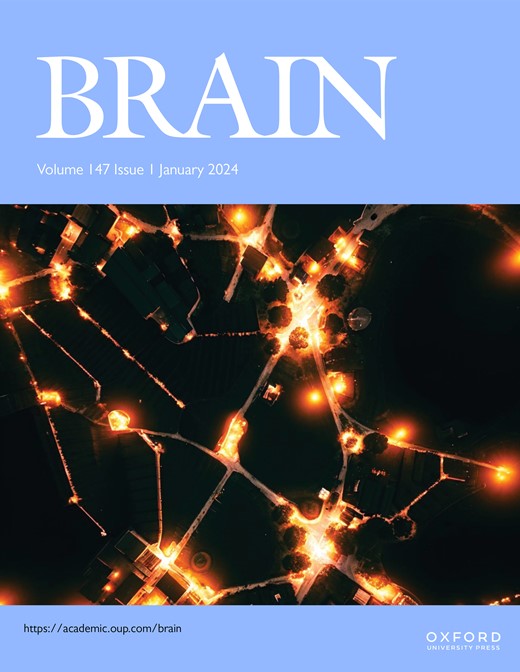轻度行为障碍-冷漠和核心阿尔茨海默病脑脊液生物标志物
IF 11.7
1区 医学
Q1 CLINICAL NEUROLOGY
引用次数: 0
摘要
冷漠是阿尔茨海默病(AD)中常见的神经精神症状(NPS),但可以在早期前驱甚至临床前阶段出现,作为轻度行为障碍(MBI-apathy)的一部分,这是一种由出现和持续的NPS定义的综合征。在痴呆症中,冷漠与较高的发病率、死亡率和照顾者困扰有关。然而,mbi冷漠在无痴呆患者中的意义,包括其与AD生物标志物的关联,仍不清楚。本研究旨在确定mbi -冷漠是否与脑脊液中淀粉样蛋白β (Aβ)和tau(磷酸化[p-tau],总[t-tau])的生物标志物证据相关。由于MBI比没有MBI的NPS更能预测痴呆的发生,我们的目的是确定冷漠和AD生物标志物之间的关系,当它作为MBI综合征的一部分发生时,当它不是。根据神经精神量表(NPI)或NPI问卷(NPI- q),对阿尔茨海默病神经影像学计划中患有轻度认知障碍(MCI)或正常认知的无痴呆参与者进行NPS状态分层——MBI-冷漠、非冷漠MBI、非MBI NPS和非NPS。线性回归模拟了NPS状态(预测因子)与脑脊液生物标志物比率(a - β42/ a - β40、p-tau181/ a - β42和t-tau/ a - β42)之间的横断面关联;主要结局)和水平(Aβ40、Aβ42、p-tau181、t-tau;探索性结果),调整年龄、性别、载脂蛋白E4、教育程度、迷你精神状态检查和NPI版本。分层线性混合效应(LME)模型评估了两年来的纵向关联,纳入了随机截距和斜率,以解释重复测量。固定效应包括NPS状态,所有线性回归模型的协变量,以及NPS状态与时间之间的交互项。在477名参与者中(176名认知正常),52名患有mbi冷漠。初步横断面分析显示,与非nps组相比,mbi -冷漠与脑脊液p-tau181/ a - β42升高相关(11.25% [2.56% - 20.68%];校正p = 0.018), t-tau181/ a - β42 (10.26% [2.42% ~ 18.70%];调整p = 0.018)。探索性分析显示,mbi -冷漠与脑脊液p-tau181升高相关(5.98% [0.50% - 11.77%];P = 0.032)。原发性LMEs显示mbi -冷漠与脑脊液p-tau181/ a - β42升高相关(11.34% [2.55% - 20.88%];校正p = 0.022)和t-tau181/ a - β42 (10.34% [2.41 ~ 18.88%];调整p = 0.022)。探索性LMEs显示,mbi -冷漠与CSF p-tau181升高相关(6.03% [0.56% - 11.81%];P = 0.032)和t-tau (4.96% [0.07% ~ 10.09%];P = 0.049)。两年来,MBI-apathy在横断面和纵向上与核心AD生物标志物显著相关,强调了其作为AD病理负担标志物的相关性。总体MBI综合评分可能反映更广泛的病理范围,值得进一步研究。本文章由计算机程序翻译,如有差异,请以英文原文为准。
Mild behavioural impairment-apathy and core Alzheimer’s disease cerebrospinal fluid biomarkers
Apathy is a common neuropsychiatric symptom (NPS) in Alzheimer’s disease (AD) but can emerge earlier in prodromal and even preclinical stages as part of mild behavioural impairment (MBI-apathy), a syndrome defined by emergent and persistent NPS. In dementia, apathy is associated with higher morbidity, mortality, and caregiver distress. However, the significance of MBI-apathy in dementia-free persons, including its associations with AD biomarkers, remains unclear. This study aimed to determine whether MBI-apathy is associated with biomarker evidence of amyloid beta (Aβ) and tau (phosphorylated [p-tau], total [t-tau]) in CSF. Because MBI predicts incident dementia better than NPS without MBI, we aimed to determine the association between apathy and AD biomarkers when it occurred as part of the MBI syndrome and when it did not. Dementia-free participants with mild cognitive impairment (MCI) or normal cognition from the Alzheimer’s Disease Neuroimaging Initiative were stratified by NPS status – MBI-apathy, non-apathy MBI, non-MBI NPS, and no-NPS – based on the Neuropsychiatric Inventory (NPI) or NPI-Questionnaire (NPI-Q). Linear regressions modelled cross-sectional associations between NPS status (predictor) and CSF biomarker ratios (Aβ42/Aβ40, p-tau181/Aβ42, and t-tau/Aβ42; primary outcomes) and levels (Aβ40, Aβ42, p-tau181, t-tau; exploratory outcomes), adjusting for age, sex, Apolipoprotein E4, education, Mini Mental State Examination, and NPI version. Hierarchical linear mixed-effects (LME) models assessed longitudinal associations over two years incorporating random intercepts and slopes to account for repeated measures. Fixed effects included NPS status, all covariates from the linear regression model, as well as an interaction term between NPS status and time. Among 477 participants (176 cognitively normal), 52 had MBI-apathy. Primary cross-sectional analyses showed that, compared to the no-NPS group, MBI-apathy was associated with higher CSF p-tau181/Aβ42 (11.25% [2.56% – 20.68%]; adjusted p = 0.018) and t-tau181/Aβ42 (10.26% [2.42% – 18.70%]; adjusted p = 0.018). Exploratory analyses revealed that MBI-apathy was associated with higher CSF p-tau181 (5.98% [0.50% – 11.77%]; p = 0.032). Primary LMEs showed that MBI-apathy was associated with higher CSF p-tau181/Aβ42 (11.34% [2.55% – 20.88%]; adjusted p = 0.022) and t-tau181/Aβ42 (10.34% [2.41–18.88%]; adjusted p = 0.022) over two years. Exploratory LMEs revealed that MBI-apathy was associated with higher CSF p-tau181 (6.03% [0.56% – 11.81%]; p = 0.032) and t-tau (4.96% [0.07% – 10.09%]; p = 0.049) over two years. MBI-apathy was significantly associated with core AD biomarkers cross-sectionally and longitudinally, over two years, underscoring its relevance as a marker of AD pathological burden. An overall MBI composite score may reflect a broader spectrum of pathology and warrants further investigation.
求助全文
通过发布文献求助,成功后即可免费获取论文全文。
去求助
来源期刊

Brain
医学-临床神经学
CiteScore
20.30
自引率
4.10%
发文量
458
审稿时长
3-6 weeks
期刊介绍:
Brain, a journal focused on clinical neurology and translational neuroscience, has been publishing landmark papers since 1878. The journal aims to expand its scope by including studies that shed light on disease mechanisms and conducting innovative clinical trials for brain disorders. With a wide range of topics covered, the Editorial Board represents the international readership and diverse coverage of the journal. Accepted articles are promptly posted online, typically within a few weeks of acceptance. As of 2022, Brain holds an impressive impact factor of 14.5, according to the Journal Citation Reports.
 求助内容:
求助内容: 应助结果提醒方式:
应助结果提醒方式:


